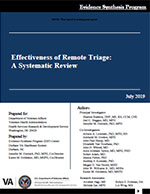
|
Prepared by: Recommended citation: |
Download PDF: Complete Report, Executive Summary, Report, Appendices
The US health care system currently faces several challenges including caring for an increasing elderly population, a large numbers of patients with multiple chronic conditions, and an uneven distribution of primary care providers across the country. The full appointment schedules of many primary care physicians compound this workforce shortage, making it challenging for many patients to access acute and chronic care within a primary care setting. Additionally, many patients experience multiple structural, financial, and logistical barriers to receiving timely care. In rural areas, for example, patients face challenges posed by distance to providers, decreased numbers of providers, and a lack of public transportation infrastructure to facilitate attending appointments.
Such access challenges may lead people to seek acute or chronic care in settings such as emergency departments (EDs) when their needs could have likely been addressed in a primary care setting. Increasingly, acute care visits take place outside of the primary care setting. Yet patients who have access to after-hours care at their usual primary care practice have lower rates of higher level care utilization. One way of providing patient access to the appropriate level of care is through technology-based systems that facilitate remote decision-making. Remote decision-making is defined as making clinical decisions in the absence of a face-to-face encounter. Further, remote decision-making can overcome barriers such as demand for in-person clinical services.
The implementation of any technology-based system is complex and requires evaluation of many factors at the patient, provider, and organizational levels. Factors related to the successful planning of such a system include the specific clinical and population contexts, the ability to sustain the process, and legal considerations around remote medical decision-making. Specific issues related to the execution of such a system include adaptability, complexity of the system, costs, external forces like incentives, and internal forces like supportive resources. Such systems have been successfully implemented in the United Kingdom, where patients requesting a sameday appointment by telephone are assessed and triaged to the appropriate level of care. Prior systematic reviews have reported that more research is necessary to determine the impact of triage and telephone consultation with patients on clinical outcomes, costs, and subsequent care utilization.
As the country's largest integrated health system, the Veterans Health Administration (VHA) has a mandate to care for Veterans across the entire United States and associated territories. Veterans established within VA may still experience barriers to accessing care, including multiple health comorbidities that limit travel, transportation concerns, or the need to access care after normal primary clinic hours. Thus, technology-based solutions to improve access are of significant interest in meeting VA's responsibility "to care for [those] who shall have borne the battle." Additionally, the recently passed MISSION Act specifically identifies telehealth via telephone or computer as channels for Veterans to receive timely care. At the request of the VA Office of Connected Care, we therefore conducted a systematic review to address the following key questions (KQs):
KQ 1:
A. For adults, what are the effects of remote triage on health care utilization, case resolution,
patient safety, patient satisfaction, and cost?
B. What is the impact of remote triage by different modalities (eg, telephone, video, web,
short message service [SMS])?
KQ 2: What are the identified best practices that impact the planning, execution, and evaluation of remote triage for adults seeking clinical care advice in a large-scale health system such as the VA?
KQ 3: What are the types of outcomes used to assess the impact of remote triage?
Effectiveness of Remote Triage: Systematic Review (Management eBrief)
Boggan J, Shoup J, Whited J, et al. Effectiveness of Acute Care Remote Triage Systems: a Systematic Review. Journal of General Internal Medicine. Published online January 2, 2020. doi:10.1007/s11606-019-05585-4
Lewinski A, Rushton S, Van Voorhees E, et al. Implementing remote triage in large health systems: A qualitative evidence synthesis. Research in Nursing and Health. 2021;44:138-154. DOI: 10.1002/nur.22093.